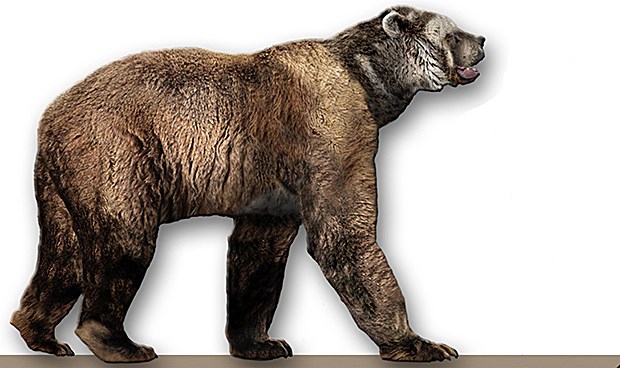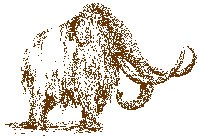|
Alaska is an exciting place to live today because of its diverse wildlife that share state with its citizens. Now imagine what it would have been like to live in Alaska during the ice age with woolly mammoths, helmeted muskox, giant short faced bears, saber toothed tigers, and steppe bison roaming around your backyard!

By Dantheman9758; CC-BY-SA-3.0 (http://creativecommons.org/licenses/by-sa/3.0/) For the giant short faced bear, evolution was too slow. If these ancient mammals had adapted like other bears in their preparations for hibernation habits in the winter, they might still be here today. Bigger than a black bear, bigger than a grizzly bear, bigger than a polar bear - the giant short faced bear (GSFB) was a gigantic predator on the mammoth steppes of ice-age Alaska. The GSFB was strictly a carnivore and hunted and ate prey both large and small. The GSFB was different from grizzly bears today: it was taller, more muscular and did not put on fat for the winter, had a huge head, and possessed short powerful jaws. They used their jaws not just to eat the flesh of their prey, but also to crush their kills' bones for food, too. Cool Fact: The giant short faced bear was native to North America and lived there for almost 1 million years. The modern grizzly bear migrated over the land bridge from Asia to North America and has only lived here about 60,000 years. Their time on earth would be like comparing a 100-year-old grandmother to her 6-year-old grandchild. STEPPE BISON Steppe bison populated the mammoth steppes more than any other ice-age animal in Alaska - so why do they call it the Mammoth Steppe? Well we will talk about that in the Woolly Mammoth section below. Steppe bison migrated from Asia to North America and the number of fossils found in Alaska outnumbered all other animals that lived on the mammoth steppe. Steppe bison were not like the bison roaming throughout the United States and Canada today. In contrast to the current bison species, they did not have the huge heads and massive shoulder humps and they did not migrate over large areas. Instead, the steppe bison looked more like a big cow. They ate lots of different kinds of grasses, so they did not have to migrate in search of food because they could eat whatever new, high-quality grass was growing at that time of year. Cool Fact: A steppe bison was found near Fairbanks, Alaska and it still had flesh on its bones (some of it was even still red). The hide (skin) was still on the animal and there were tears in the hide and flesh, telling us this bison was attacked and probably killed by lions! Minerals from the soil in which the bison was found stained the skin a dark blue, so the bison was named Blue Babe. 
WOOLLY MAMMOTH |
Last updated: April 14, 2015
